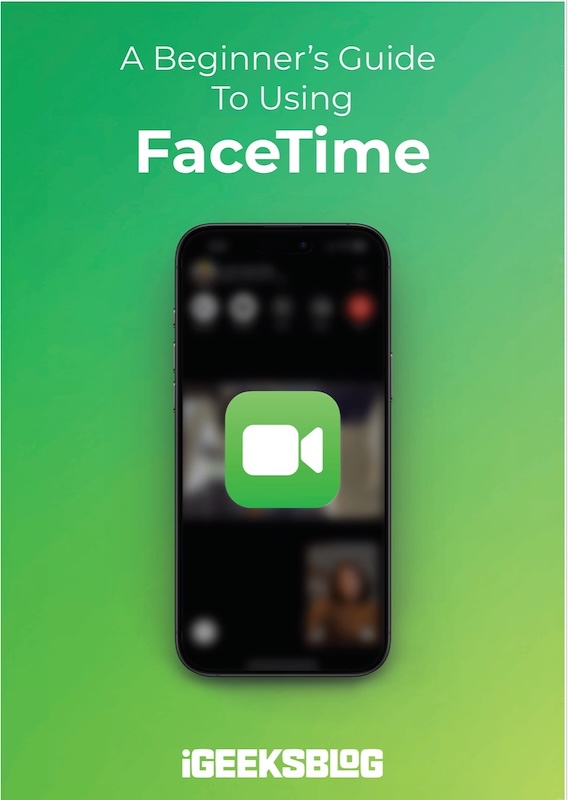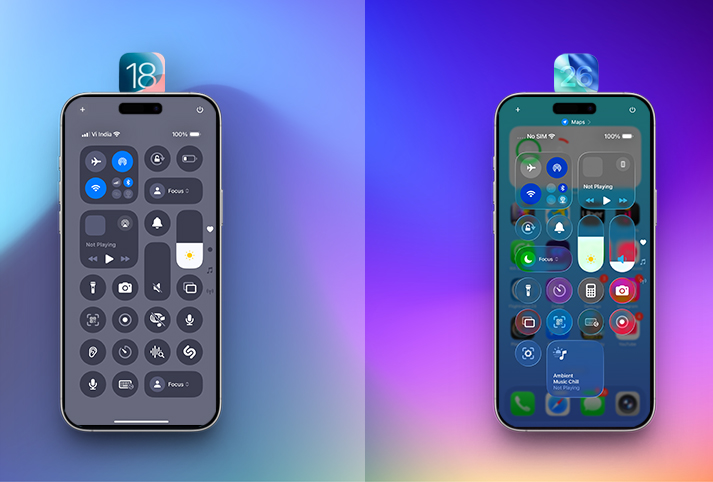
FaceTime Like a Pro
Get our exclusive Ultimate FaceTime Guide 📚 — absolutely FREE when you sign up for our newsletter below.

FaceTime Like a Pro
Get our exclusive Ultimate FaceTime Guide 📚 — absolutely FREE when you sign up for our newsletter below.
Wondering how iOS 26 compares to iOS 18? From a stunning Liquid Glass design to a brand-new Games app, discover the biggest changes Apple made in its latest iPhone update.
Each year, Apple enhances the iPhone experience with visual upgrades and feature-packed updates. While iOS 18 brought quality-of-life improvements and marked the arrival of Apple Intelligence, the newly introduced iOS 26 pushes the envelope further—both in design and functionality.
If you’re wondering what makes iOS 26 stand apart from iOS 18, here are the most noticeable changes you’ll experience right away.
| Feature Category | iOS 18 | iOS 26 |
|---|---|---|
| Design | Standard flat UI | Liquid Glass UI with depth, translucency, animations |
| Messages App | RCS support, emoji Tapbacks | Chat backgrounds, polls, themed chats, new layout |
| Photos App | Unified Library/Albums view | Separated Library & Collections, Spatial Photos |
| Siri & Search | Smarter suggestions, Apple Intelligence intro | Visual Look Up+, Circle to Search-style features |
| New Apps | Passwords App | All-new Games App, Preview App |
| Battery Tools | Optimized Charging, battery health info | Adaptive Power Mode, Battery Insights with usage trends |
| Performance | Faster animations, better stability | Smarter multitasking, better efficiency |
| Call Features | Live Voicemail | Call Screening with real-time summaries, Live Translation |
| Device Support | iPhone XR and newer | iPhone 11 and newer (XR, XS series dropped) |
| Privacy & Security | On-device processing for most AI tasks | Enhanced privacy with more on-device intelligence tools |
Starting from the new system-wide design overhaul, you get to enjoy more lock screen customization, a revamped Messages, Camera, and Photos app interface, a new Games app, and more. Below, we have talked about each in detail:

As soon as you update your iPhone to iOS 26, you’ll be astonished by a sleek, fluid interface called Liquid Glass. Inspired by visionOS, this new design has transformed everything, from toolbars to app icons and widgets, with depth, translucency, and motion-reactive elements. This visual overhaul looks way more impressive than the flatter design of iOS 18.

Apple adds a brand new app to the iPhone with each new iOS iteration. Last year, it was the Passwords app. This time, Apple has discontinued Game Center and introduced a standalone Games app with iOS 26.
The app serves as a central hub for gamers, where they can view all installed games, track progress and achievements, and access Game Center features—all in one polished interface.

Many users complained when iOS 18 revamped the Photos app, merging the library with Albums on a single scrollable screen. It appears Apple listened to users’ dismay as iOS 26 again revamps the Photos app, keeping the Library and Albums in two separate tabs. So, if you were dissatisfied with how iOS 18 changed the Photos app, you are in for a treat in iOS 26.

The Camera app now includes a more intuitive layout with quick access to manual controls and faster mode switching. Compared to iOS 18, this makes capturing the perfect shot easier and more responsive.

After years of staying untouched, the Phone app gets a visual refresh in iOS 26. It now combines Favorites, Recents, and Voicemails into a sleek, unified interface—something missing in iOS 18.

While iOS 18 added RCS and emoji Tapbacks, iOS 26 gives Messages a full redesign. You’ll enjoy customizable chat backgrounds, Apple Cash support in group chats, themed conversations, and enhanced chat organization.
Apple’s updates in iOS 26 are driven by:
All iOS 18 users, except those with iPhone XR, XS, and XS Max, can update their iPhone to iOS 26. This means that every iPhone, starting with the iPhone 11 series, is compatible with iOS 26. However, simply having an iOS 26-compatible iPhone doesn’t mean you have access to all iOS 26 features. Similar to iOS 18, only users with an iPhone 15 Pro or newer model can access the new Apple Intelligence feature introduced in iOS 26.
The first developer beta of iOS 18 was released immediately after the WWDC 2024 Keynote, i.e., June 10, 2024, followed by the public beta release on July 10, 2024. The stable version of iOS 18 was released on September 16, 2024, one week after the iPhone 16 launch event.
Similar to iOS 18, the first iOS 26 developer beta was also released immediately after the WWDC 2025 Keynote, i.e., June 9, 2025. The first public beta of iOS 26 released on July 8. Apple has yet again followed a similar pattern and has released the stable version of iOS 26 on September 15, 2024.
The new Liquid Glass design brings depth, motion, and elegance, making everyday interactions feel fresh and futuristic. Plus, the redesigned Messages, Photos, and Camera apps offer faster access. All this, together with the deep integrated features like Call Screening, Live Translation, and smart battery insights, modernizes your iPhone use across all levels.
If you own an iOS 26-supported iPhone, there’s no reason why you shouldn’t upgrade to iOS 26 from iOS 18. With iOS 26, Apple took a giant leap in terms of design language, and the first impressions are awe-inspiring.
Yes, unlike iOS 18, iOS 26 isn’t very feature-packed, as the new update largely focuses on a design overhaul. However, this doesn’t change the fact that all iOS 18 features are also available on iOS 26, and some of them are significantly enhanced.
However, if you’re satisfied with iOS 18 and don’t own an iPhone 11 or newer, sticking with iOS 18 isn’t a bad option. But if you’re considering an upgrade and have the budget for it, moving to a newer iPhone could be worthwhile.
Which iOS 26 feature are you most excited about? Have you noticed any other major differences? Drop your thoughts in the comments.
FAQs
Yes. iOS 26 introduces a visually rich design, smarter system tools, and improved app interfaces—especially if you’re on a newer iPhone.
Not necessarily. While older models like the iPhone 11 may not run animations as smoothly, Apple has optimized performance across supported devices. Battery health and storage space may still affect your experience.
Read More